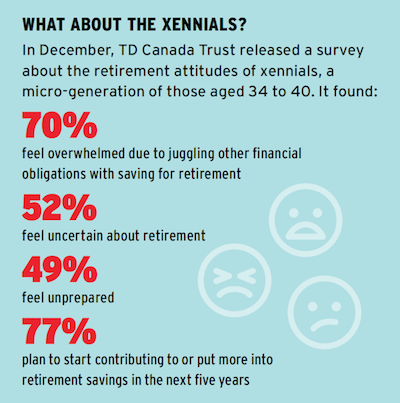
While retirement may not yet be at the top of millennials’ priority lists, it won’t be long before they arrive on the pension scene. How can the industry prepare for their arrival? And what might the rejuvenation look like?
Let’s start by examining the pension world as we know it today. On the workplace front, traditional defined benefit pensions continue to dwindle, while capital accumulation plans gain momentum. Plan sponsors, meanwhile, recognize the need to offer financial wellness and take a holistic approach to retirement. As for the investment industry, it has been building target-date funds to relieve plan members of having to become investment experts and determine their own investment portfolios.
Read: 2017 CAP Suppliers Report: Employers tailoring CAPs for a more holistic financial picture
On the government front, we’ve seen a number of developments, including pooled registered pension plans, voluntary retirement savings plans and the expansion of the Canada Pension Plan. It’s all very good, but the pension landscape today is more in line with the needs of baby boomers and generation Xers. Undoubtedly, it needs to evolve to suit a new era focused on millennials and their generation Z siblings.
With those drivers of change in mind, let’s look at how to prepare for millennials’ ascendancy in the retirement landscape. Here are some tips:
1. Hear them out
Like any other generation, millennials like to have a voice. They also trust their peers and consult them for gathering information and making decisions before taking professional advice. For plan sponsors, it’s important to make room for the millennial workforce on the pension committees or other governance and advisory bodies. A millennial representative on the pension committee can help employers shape the retirement plan to meet the unique needs of that generation. A millennial spokesperson can also help plan sponsors achieve acceptance and appreciation by other workers in that group.
Millennials are hungry for financial education. The ingredients for a successful program include delivering action-driven education, using social media, integrating technology with human contact, being genuine and empathetic and not being boring and stale.
Read: 80% of Canadians want employer-provided financial education: survey
It’s important to customize financial education in order to meet the varying needs of different generations. Late-career baby boomers have more of an interest in drawing a retirement income and making sure it lasts them for the rest of their life than in tax strategies that may maximize their savings. Conversely, younger workers may want to know more about maximizing their savings or reducing their debts while covering daily living expenses.

To deliver financial education, a multimedia approach can be useful. However, we know that millennials value human contact, so don’t leave it all to social media and robo-advisors. It’s important to be empathetic and genuine and concentrate on their priorities and wants. It’s also good to break out of traditional forms of communication and education and be fun and entertaining. Moreover, plan sponsors should accept that millennials are focusing more on getting by today than saving for retirement.
The great recession and the subsequent volatile markets have left their mark on millennials. As a result, we have a very skeptical generation that’s leery of investing or taking advice from a professional advisor. Those millennials who do invest in stock markets are more likely than any other generation to demand high standards of socially responsible investing.
Read: CRM2, regulatory actions abroad put fee transparency under the microscope
To build their trust, highlight the advantages of investing in institutional funds under a workplace retirement or savings plan. Institutional funds usually carry lower fees when compared to the retail market and are more transparent in their fee structure. By investing in a workplace plan, millennial members enjoy professional fund management at a lower cost compared to what they can buy on their own in the retail market.
Furthermore, if plan sponsors have a robust governance structure in place to oversee the funds’ performance, they should also broadcast that information in order to alleviate any concerns the millennial workforce may have. Having a millennial representative on the governance body strengthens the case further.
In selecting funds, consider those offering socially responsible investments as an added option. And when partnering with a provider, choose one that has a state-of-the-art platform and isn’t afraid to think differently. If the provider offers financial advice, make sure it’s objective and free of any commercial bias. Be transparent and disclose all related fees in full.
As ideas around retirement have evolved, the notion of pensions as deferred wages paid to those who render long service has slowly changed. Over time, governments introduced vesting and portability rules to help protect workers who terminate their employment before retirement. But the rules weren’t the end of paternalism, as the transferred benefits are subject to locking-in provisions of varying degrees.
With millennials arriving on the pension scene, the demise of all things paternalistic is on the horizon. Locking-in rules may no longer have a place; portability provisions need enhancement; and innovative plan designs will emerge.
Read: How can Canada’s retirement system better address pension portability?
Let’s look at why that picture is plausible. Modern retirement is no longer a single point where a productive working life ends and people spend the rest of their lives in retreat. Some may continue to work, while others may completely withdraw from the working world and spend their retirement years in leisure. People may go in and out of retirement, change careers or do nothing. Paternalistic measures, such as locking-in rules, are no longer relevant to the modern concept of retirement.
The millennial workforce is likely to be much more mobile than previous generations. Freelancing and self-employment are much more prevalent among millennials, who are more likely to move in and out of a corporate job repeatedly throughout their careers. Enhanced portability measures will be necessary to help millennials preserve and consolidate the retirement benefits they earn under multiple employers.
Broadening the focus
To meet the demands of millennials, we need to innovate. We also need to broaden our focus and build plans that go beyond providing income in retirement. As an example, plan sponsors can offer group tax-free savings accounts as an added feature to their traditional retirement savings plans. The group TFSA can assist with short-term financial goals, such as saving for a down payment on a home or paying off student debt.
Read: Is it time to allow annuities in TFSAs?
Exciting times are ahead as this potentially rich generation sweeps the pension landscape to drive change. It’s up to the industry, in turn, to embrace the opportunity.
Bita Jenab is an actuary and the founder of RetirementWorks Services Inc.
